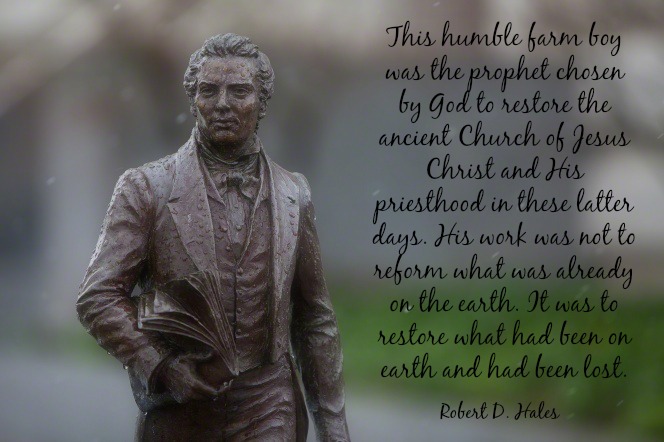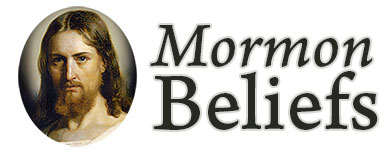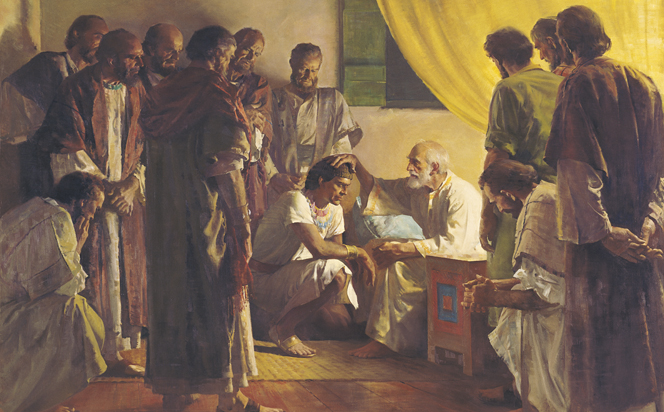Most members of The Church of Jesus Christ of Latter-day Saints have been confronted with the topic of polygamy at some point in their lives. It can be controversial and a trial of faith. But this is nothing new—history shows that it was both controversial and a trial of faith for early Latter-day Saints as well. How do modern Mormons face this challenge? I can’t speak for others, but this is my story.
For me, the issue of plural marriage came to the forefront recently as I was researching some of my family history. I came across some surprising relationships. In at least two instances, sisters married the same man. As one of six girls in my family, this really hit home for me. It was hard enough to share clothes, but I can’t imagine sharing my husband. So I took a deeper look into plural marriage, and I discovered it is much more complex than it seems.
Before this time, I thought of plural marriage as a trial of faith for those who were asked to live it, a way to take care of the widows, or maybe a way to for the Lord to raise up a righteous generation quickly, as taught in the scriptures. (See Jacob 2:30.) And certainly plural marriage did all of these things. But viewing this practice in such one-dimensional terms doesn’t show the whole picture. In fact, there are three layers of the plural marriage issue that helped me to more fully comprehend its place in Mormonism: Joseph Smith’s polygamy, continuing revelation and family history. Each will be discussed in its own article. Some of these overlap, but each tells a distinct aspect of the story of plural marriage that helps to explain why men and women participated in it (and how sisters could marry the same man and be OK with it).
Joseph Smith & the Mormon Church

No one can fully understand polygamy without knowing who Joseph Smith was and why anyone would follow him. At the age of 14, young Joseph Smith knelt in a grove of trees and asked God which church he should join. In answer to his prayer, Heavenly Father and Jesus Christ appeared to him and told him that he should not join any church, but that through him They would restore Christ’s Church to the earth. Elder Robert D. Hales, of the Quorum of the Twelve Apostles, said of Joseph Smith:
This humble farm boy was the prophet chosen by God to restore the ancient Church of Jesus Christ and His priesthood in these latter days. This restoration was to be the last, the dispensation of the fulness of times, restoring all the priesthood blessings which man could possess on earth. With this divine commission, his work was not to reform nor was it to protest what was already on the earth. It was to restore what had been on earth and had been lost.
This restoration included the priesthood of God as well as all of the ordinances required to return and live with God again. Elder Neil L. Andersen said:
Joseph Smith is the prophet of the Restoration. His spiritual work began with the appearance of the Father and the Son, followed by numerous heavenly visitations. He was the instrument in God’s hands in bringing forth sacred scripture, lost doctrine, and the restoration of the priesthood.
It is important to understand that Joseph Smith was not just a charismatic speaker, nor did he just have a powerful presence that drew people to him. He was a prophet of God, and the truths that he restored were (and are) all about bringing people to our Heavenly Father. And it all starts with families.
Marriage (and Families) for Eternity
Our Heavenly Father’s plan for His children begins with families. We are all spirit children of our Heavenly Father, who is God. As such, we are all part of His family. And He sent us to earth in families to see if we would obey His commandments in all things. Knowing that we would sin, our loving Father sent His Son, Jesus Christ, to earth to atone for our sins as well as to set the example for us to follow.
If we have faith in Christ, try to repent of our sins and strive to be obedient to “the laws and ordinances of the gospel” (Articles of Faith 1:3) we will receive eternal life, which is the ability to live in God’s full presence as families. This is what Mormons call “exaltation,” while Mormons believe that nearly all people will receive “salvation,” which means to inherit some kingdom of heaven with a portion of God’s presence.
A family with eternal potential begins when a man and a woman unite in marriage, thus creating a new family unit. Through the Prophet Joseph Smith, the Lord revealed:
In the celestial glory there are three heavens or degrees; and in order to obtain the highest, a man must enter into this order of the priesthood [meaning the new and everlasting covenant of marriage]; and if he does not, he cannot obtain it. He may enter into the other, but that is the end of his kingdom; he cannot have an increase (Doctrine & Covenants 131:1-4).
Thus, marriage is important. But not just marriage, covenant marriage. A covenant is a sacred two-way promise between God and a man or woman, and God sets the terms. In The Church of Jesus Christ, members make these sacred covenants with God in temples, which are, literally, the House of the Lord. To obtain the highest glory, or exaltation, in the kingdom of heaven, man and woman must be sealed in the temple, by the proper authority (one who has the priesthood keys).
Sister Silvia H. Allred, at the time the first counselor in the Relief Society General Presidency, said:
The covenants we make with the associated ordinances we receive in the temple become our credentials for admission into God’s presence. These covenants elevate us beyond the limits of our own power and perspective. We make covenants to show our devotion to build up the kingdom. We become covenant people as we are placed under covenant to God. All the promised blessings are ours through our faithfulness to these covenants.
And the marriage is the highest covenant that we make with our spouse and our God. Brent Top, dean of religious education at Brigham Young University, explained:
One contemporary of the Prophet [Joseph] said that his life’s greatest motto after “God and His Kingdom” was that of “Family and friends.” (See Johnson Letter, p. 4.) These two mottos were united in Joseph’s life, for it had been taught him, through experience and revelation, that he could not attain the former without the latter. …
The Prophet had seen in vision that marriage should be for eternity. It is no wonder that he so vigorously taught the Saints to love their spouses fully, to be tender and faithful. His own love for Emma and the children illustrated his firm conviction that families can be forever.
President Boyd K. Packer taught:
The ultimate purpose of every teaching, every activity in the Church is that parents and their children are happy at home, sealed in an eternal marriage, and linked to their generations.
Plural Marriage
The background information is essential to understanding plural marriage, or a man being married to more than one woman at a time. Joseph Smith and other early members of The Church of Jesus Christ understood that they were living in “the dispensation of the fullness of times” when all things would be restored to the earth. But they weren’t necessarily prepared for that to include the practice of plural marriage. But when the Lord revealed to Joseph Smith that marriages and families could last beyond the grave, He also revealed that plural marriage would be restored to the earth.
There is likely more than one reason that the Lord instituted plural marriage. A recent article by The Church of Jesus Christ explained:
Latter-day Saints do not understand all of God’s purposes in instituting, through His prophets, the practice of plural marriage. The Book of Mormon identifies one reason for God to command it: to increase the number of children born in the gospel covenant in order to “raise up seed unto [the Lord].”
Plural marriage did result in the birth of large numbers of children within faithful Latter-day Saint homes. It also shaped 19th-century Mormon society in many ways: marriage became available to virtually all who desired it; per-capita inequality of wealth was diminished as economically disadvantaged women married into more financially stable households; and ethnic intermarriages were increased, which helped to unite a diverse immigrant population. Plural marriage also helped create and strengthen a sense of cohesion and group identification among Latter-day Saints. Church members came to see themselves as a “peculiar people,” covenant-bound to carry out the commands of God despite outside opposition.
That doesn’t mean that it was easy for any involved. It was challenging and, often, a trial of faith. But with the trials also come the blessings, and this is true for plural marriage.
Uniting Families

A husband and wife who are sealed in an LDS temple, such as this one in Logan, Utah, can be united for eternity.
The practice of plural marriage in the early days of the modern Church focused primarily on uniting families—and Church members—in the eternities. Thus, there were two kinds of sealings, one for time and eternity and another for eternity only. There is an important distinction between these two, because marriages for ‘time and eternity’ involved living together as husband and wife (and having sexual relations), while ‘eternity only’ did not involve living together as husband and wife (nor did it involve sexual relations). The Prophet Joseph was involved in both types of marriages.
The Prophet Joseph was indeed sealed to women who were already married. However, those unions were for eternity only. His union with 14-year-old Helen Mar Kimball was for time and eternity, but they never cohabited, and after Joseph’s death, Helen entered a monogamous marriage which then became polygamous.) An article by The Church of Jesus Christ explained:
There are several possible explanations for this practice. These sealings may have provided a way to create an eternal bond or link between Joseph’s family and other families within the Church. These ties extended both vertically, from parent to child, and horizontally, from one family to another. Today such eternal bonds are achieved through the temple marriages of individuals who are also sealed to their own birth families, in this way linking families together. Joseph Smith’s sealings to women already married may have been an early version of linking one family to another. In Nauvoo, most if not all of the first husbands seem to have continued living in the same household with their wives during Joseph’s lifetime, and complaints about these sealings with Joseph Smith are virtually absent from the documentary record. …
Another possibility is that, in an era when life spans were shorter than they are today, faithful women felt an urgency to be sealed by priesthood authority. Several of these women were married either to non-Mormons or former Mormons, and more than one of the women later expressed unhappiness in their present marriages. Living in a time when divorce was difficult to obtain, these women may have believed a sealing to Joseph Smith would give them blessings they might not otherwise receive in the next life.
Why the Apparent Secrecy?
The evidence and information that we have about plural marriage in the early days of The Church of Jesus Christ is fragmented at best and, in other instances, nonexistent. Why is this? Zina Huntington, one of the Prophet Joseph’s plural wives, wrote [John Wight, “Evidence from Zina D. Huntington Young,” Interview with Zina, October 1, 1898, Saints Herald 52 (January 11, 1905): 29; see also in Martha Sonntag Bradley and Mary Brown Firmage Woodward, Four Zinas: A Story of Mothers and Daughters on the Mormon Frontier (Salt Lake City: Signature Books, 2000), 114. ]:
It [plural marriage] was something too sacred to be talked about; it was more to me than life or death. I never breathed it for years. I will tell you the facts. I had dreams. I am no dreamer—but I had dreams that I could not account for. I know this is the work of the Lord; it was revealed to me, even when young. Things were presented to my mind that I could not account for. When Joseph Smith revealed this order, I knew what it meant; the Lord was preparing my mind to receive it.
Another woman named Sarah Studevant Leavitt recorded [Sarah Studebant Leavitt, “History of Sarah Studevant Leavitt,” n.p., copied from her history by Juanita Leavitt Pulsipher, June 1919, 23; see also Richard N. Skousen and W. Cleon Skousen, Brother Joseph: Seer of a New Dispensation, vol. 2 (Orem, Utah: Verity Publishing, 2005), 847]:
My mind was carried away from the earth and I had a view of the order of the celestial kingdom. I saw that it [plural marriage] was the order there and oh, how beautiful. I was filled with love and joy that was unspeakable. I waked my husband and told him of the views I had and that the ordinance was from the Lord, but it would damn thousands. It was too sacred for fools to handle, for they would use it to gratify their lustful desires.
Thus, the sacred nature of plural marriage, and the Latter-day Saints’ desire to keep it sacred, may be one reason that the early records are fragmented. Zina Huntington may also provide another bit of insight into the reluctance of many early Latter-day Saints to discuss their involvement in plural marriage when she said [Zina Huntington Jacobs, autobiographical sketch, Zina Card Brown Family Collection, Church History Library, Salt Lake City; spelling modernized.]:
I made a greater sacrifice than to give my life, for I never anticipated again to be looked upon as an honorable woman. … [Nevertheless] I searched the scripture & by humble prayer to my Heavenly Father I obtained a testimony for myself.
Plural marriage was introduced incrementally, and participants were asked to keep their marriages confidential. They knew there would come a time when their actions would be known, but until then they were asked to not discuss it publicly. It was not until the Latter-day Saints moved West to Utah that they openly practiced and discussed plural marriage. Thus, the historical records of the early plural marriages are thin.
It’s important to remember that at its heart, plural marriage was a religious practice. It was the early Latter-day Saints’ desire to faithfully obey the commandments of God as well as to ensure that everyone had the opportunity to join the family of God in the eternities that led to the unusual unions—such as sisters to the same husband. Their view of marriage was religious, and they saw this as a trial of their faith.
In his revelation, Joseph Smith was told that those who righteously practiced polygamy would receive “crowns of eternal lives” and “exaltation in the eternal worlds” (Doctrine & Covenants 132:55, 63). It is the sincere desire of all Latter-day Saints to receive these blessings. When we view this principle through the eyes of those who practiced it, we gain a measure of understanding. It was not easy, nor did polygamous marriages always stay the course, but in most cases, participants grew closer to God and created a unified bond that still exists in The Church of Jesus Christ today.

